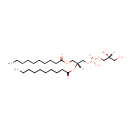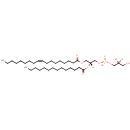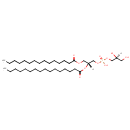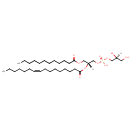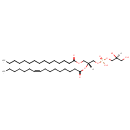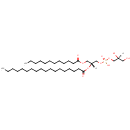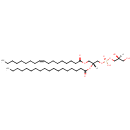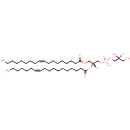
Search Results for compounds
Searching compounds for
returned 4373 results.
Displaying compounds 2441 - 2450 of
4373 in total
PA(18:0/18:0) (PAMDB006377)
IUPAC:
Not Available
CAS: Not Available
Description: a lysophosphatidic acid. It is a glycerophospholipid in which a phosphate moiety occupies a glycerol substitution site.
tetrahydropteroyl mono-L-glutamate (PAMDB006378)
IUPAC:
Not Available
CAS: Not Available
Description: Tetrahydropteroyl mono-L-glutamate, also known as tetrahydrofolate is a soluble coenzyme (vitamin B9) that is synthesized de novo by plants and microorganisms, and absorbed from the diet by animals. It is composed of three distinct parts: a pterin ring, a p-ABA (p-aminobenzoic acid) and a polyglutamate chain with a number of residues varying between 1 and 8. Only the tetra-reduced form of the molecule serves as a coenzyme for C1 transfer reactions. In biological systems, the C1-units exist under various oxidation states and the different tetrahydrofolate derivatives constitute a family of related molecules named indistinctly under the generic term folate. (PMID 16042593)
PG(10:0/10:0) (PAMDB006379)
IUPAC:
[(2R)-2,3-bis(decanoyloxy)propoxy][(2R)-2,3-dihydroxypropoxy]phosphinic acid
CAS: Not Available
Description: PG(10:0/10:0) is a phosphatidylglycerol. Phosphatidylglycerols consist of a glycerol 3-phosphate backbone esterified to either saturated or unsaturated fatty acids on carbons 1 and 2. As is the case with diacylglycerols, phosphatidylglycerols can have many different combinations of fatty acids of varying lengths and saturation attached to the C-1 and C-2 positions. PG(10:0/10:0), in particular, consists of two decanoyl chains at positions C-1 and C-2. In Pseudomonas aeruginosa glycerophospholipid metabolism, phosphatidylglycerol is formed from phosphatidic acid (1,2-diacyl-sn-glycerol 3-phosphate) by a sequence of enzymatic reactions that proceeds via two intermediates, cytidine diphosphate diacylglycerol (CDP-diacylglycerol) and phosphatidylglycerophosphate (PGP, a phosphorylated phosphatidylglycerol). Phosphatidylglycerols, along with CDP-diacylglycerol, also serve as precursor molecules for the synthesis of cardiolipin, a phospholipid found in membranes.
PG(14:0/18:1(9Z)) (PAMDB006380)
IUPAC:
[(2S)-2,3-dihydroxypropoxy][(2R)-3-[(9Z)-octadec-9-enoyloxy]-2-(tetradecanoyloxy)propoxy]phosphinic acid
CAS: Not Available
Description: PG(14:0/18:1(9Z)) is a phosphatidylglycerol. Phosphatidylglycerols consist of a glycerol 3-phosphate backbone esterified to either saturated or unsaturated fatty acids on carbons 1 and 2. As is the case with diacylglycerols, phosphatidylglycerols can have many different combinations of fatty acids of varying lengths and saturation attached to the C-1 and C-2 positions. PG(14:0/18:1(9Z)), in particular, consists of one tetradecanoyl chain to the C-1 atom, and one 9Z-octadecenoyl to the C-2 atom. In Pseudomonas aeruginosa glycerophospholipid metabolism, phosphatidylglycerol is formed from phosphatidic acid (1,2-diacyl-sn-glycerol 3-phosphate) by a sequence of enzymatic reactions that proceeds via two intermediates, cytidine diphosphate diacylglycerol (CDP-diacylglycerol) and phosphatidylglycerophosphate (PGP, a phosphorylated phosphatidylglycerol). Phosphatidylglycerols, along with CDP-diacylglycerol, also serve as precursor molecules for the synthesis of cardiolipin, a phospholipid found in membranes.
PG(16:0/15:0) (PAMDB006381)
IUPAC:
[(2S)-2,3-dihydroxypropoxy][(2R)-2-(hexadecanoyloxy)-3-(pentadecanoyloxy)propoxy]phosphinic acid
CAS: Not Available
Description: PG(16:0/15:0) is a phosphatidylglycerol. Phosphatidylglycerols consist of a glycerol 3-phosphate backbone esterified to either saturated or unsaturated fatty acids on carbons 1 and 2. As is the case with diacylglycerols, phosphatidylglycerols can have many different combinations of fatty acids of varying lengths and saturation attached to the C-1 and C-2 positions. PG(16:0/15:0), in particular, consists of one hexadecanoyl chain to the C-1 atom, and one pentadecanoyl to the C-2 atom. In Pseudomonas aeruginosa glycerophospholipid metabolism, phosphatidylglycerol is formed from phosphatidic acid (1,2-diacyl-sn-glycerol 3-phosphate) by a sequence of enzymatic reactions that proceeds via two intermediates, cytidine diphosphate diacylglycerol (CDP-diacylglycerol) and phosphatidylglycerophosphate (PGP, a phosphorylated phosphatidylglycerol). Phosphatidylglycerols, along with CDP-diacylglycerol, also serve as precursor molecules for the synthesis of cardiolipin, a phospholipid found in membranes.
PG(16:1(9Z)/12:0) (PAMDB006383)
IUPAC:
[(2S)-2,3-dihydroxypropoxy][(2R)-3-(dodecanoyloxy)-2-[(9Z)-hexadec-9-enoyloxy]propoxy]phosphinic acid
CAS: Not Available
Description: PG(16:1(9Z)/12:0) is a phosphatidylglycerol. Phosphatidylglycerols consist of a glycerol 3-phosphate backbone esterified to either saturated or unsaturated fatty acids on carbons 1 and 2. As is the case with diacylglycerols, phosphatidylglycerols can have many different combinations of fatty acids of varying lengths and saturation attached to the C-1 and C-2 positions. PG(16:1(9Z)/12:0), in particular, consists of one 9Z-hexadecenoyl chain to the C-1 atom, and one dodecanoyl to the C-2 atom. In Pseudomonas aeruginosa glycerophospholipid metabolism, phosphatidylglycerol is formed from phosphatidic acid (1,2-diacyl-sn-glycerol 3-phosphate) by a sequence of enzymatic reactions that proceeds via two intermediates, cytidine diphosphate diacylglycerol (CDP-diacylglycerol) and phosphatidylglycerophosphate (PGP, a phosphorylated phosphatidylglycerol). Phosphatidylglycerols, along with CDP-diacylglycerol, also serve as precursor molecules for the synthesis of cardiolipin, a phospholipid found in membranes.
PG(16:1(9Z)/15:0) (PAMDB006384)
IUPAC:
[(2S)-2,3-dihydroxypropoxy][(2R)-2-[(9Z)-hexadec-9-enoyloxy]-3-(pentadecanoyloxy)propoxy]phosphinic acid
CAS: Not Available
Description: PG(16:1(9Z)/15:0) is a phosphatidylglycerol. Phosphatidylglycerols consist of a glycerol 3-phosphate backbone esterified to either saturated or unsaturated fatty acids on carbons 1 and 2. As is the case with diacylglycerols, phosphatidylglycerols can have many different combinations of fatty acids of varying lengths and saturation attached to the C-1 and C-2 positions. PG(16:1(9Z)/15:0), in particular, consists of one 9Z-hexadecenoyl chain to the C-1 atom, and one pentadecanoyl to the C-2 atom. In Pseudomonas aeruginosa glycerophospholipid metabolism, phosphatidylglycerol is formed from phosphatidic acid (1,2-diacyl-sn-glycerol 3-phosphate) by a sequence of enzymatic reactions that proceeds via two intermediates, cytidine diphosphate diacylglycerol (CDP-diacylglycerol) and phosphatidylglycerophosphate (PGP, a phosphorylated phosphatidylglycerol). Phosphatidylglycerols, along with CDP-diacylglycerol, also serve as precursor molecules for the synthesis of cardiolipin, a phospholipid found in membranes.
PG(18:0/12:0) (PAMDB006385)
IUPAC:
[(2S)-2,3-dihydroxypropoxy][(2R)-3-(dodecanoyloxy)-2-(octadecanoyloxy)propoxy]phosphinic acid
CAS: Not Available
Description: PG(18:0/12:0) is a phosphatidylglycerol. Phosphatidylglycerols consist of a glycerol 3-phosphate backbone esterified to either saturated or unsaturated fatty acids on carbons 1 and 2. As is the case with diacylglycerols, phosphatidylglycerols can have many different combinations of fatty acids of varying lengths and saturation attached to the C-1 and C-2 positions. PG(18:0/12:0), in particular, consists of one octadecanoyl chain to the C-1 atom, and one dodecanoyl to the C-2 atom. In Pseudomonas aeruginosa glycerophospholipid metabolism, phosphatidylglycerol is formed from phosphatidic acid (1,2-diacyl-sn-glycerol 3-phosphate) by a sequence of enzymatic reactions that proceeds via two intermediates, cytidine diphosphate diacylglycerol (CDP-diacylglycerol) and phosphatidylglycerophosphate (PGP, a phosphorylated phosphatidylglycerol). Phosphatidylglycerols, along with CDP-diacylglycerol, also serve as precursor molecules for the synthesis of cardiolipin, a phospholipid found in membranes.
PG(18:0/18:1(9Z)) (PAMDB006390)
IUPAC:
[(2S)-2,3-dihydroxypropoxy][(2R)-3-[(9Z)-octadec-9-enoyloxy]-2-(octadecanoyloxy)propoxy]phosphinic acid
CAS: Not Available
Description: PG(18:0/18:1(9Z)) is a phosphatidylglycerol. Phosphatidylglycerols consist of a glycerol 3-phosphate backbone esterified to either saturated or unsaturated fatty acids on carbons 1 and 2. As is the case with diacylglycerols, phosphatidylglycerols can have many different combinations of fatty acids of varying lengths and saturation attached to the C-1 and C-2 positions. PG(18:0/18:1(9Z)), in particular, consists of one octadecanoyl chain to the C-1 atom, and one 9Z-octadecenoyl to the C-2 atom. In Pseudomonas aeruginosa glycerophospholipid metabolism, phosphatidylglycerol is formed from phosphatidic acid (1,2-diacyl-sn-glycerol 3-phosphate) by a sequence of enzymatic reactions that proceeds via two intermediates, cytidine diphosphate diacylglycerol (CDP-diacylglycerol) and phosphatidylglycerophosphate (PGP, a phosphorylated phosphatidylglycerol). Phosphatidylglycerols, along with CDP-diacylglycerol, also serve as precursor molecules for the synthesis of cardiolipin, a phospholipid found in membranes.
PG(18:1(11Z)/18:1(9Z)) (PAMDB006392)
IUPAC:
[(2S)-2,3-dihydroxypropoxy][(2R)-2-[(11Z)-octadec-11-enoyloxy]-3-[(9Z)-octadec-9-enoyloxy]propoxy]phosphinic acid
CAS: Not Available
Description: PG(18:1(11Z)/18:1(9Z)) is a phosphatidylglycerol. Phosphatidylglycerols consist of a glycerol 3-phosphate backbone esterified to either saturated or unsaturated fatty acids on carbons 1 and 2. As is the case with diacylglycerols, phosphatidylglycerols can have many different combinations of fatty acids of varying lengths and saturation attached to the C-1 and C-2 positions. PG(18:1(11Z)/18:1(9Z)), in particular, consists of one 11Z-octadecenoyl chain to the C-1 atom, and one 9Z-octadecenoyl to the C-2 atom. In Pseudomonas aeruginosa glycerophospholipid metabolism, phosphatidylglycerol is formed from phosphatidic acid (1,2-diacyl-sn-glycerol 3-phosphate) by a sequence of enzymatic reactions that proceeds via two intermediates, cytidine diphosphate diacylglycerol (CDP-diacylglycerol) and phosphatidylglycerophosphate (PGP, a phosphorylated phosphatidylglycerol). Phosphatidylglycerols, along with CDP-diacylglycerol, also serve as precursor molecules for the synthesis of cardiolipin, a phospholipid found in membranes.


